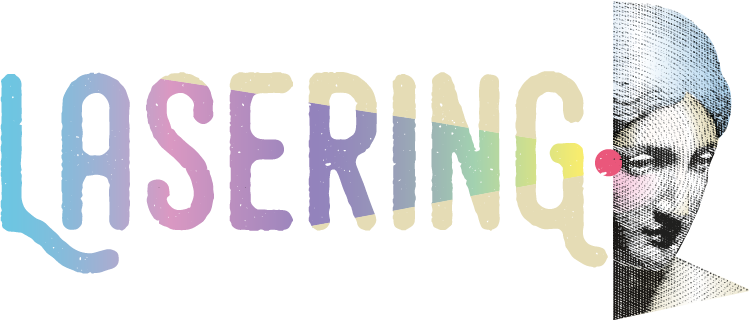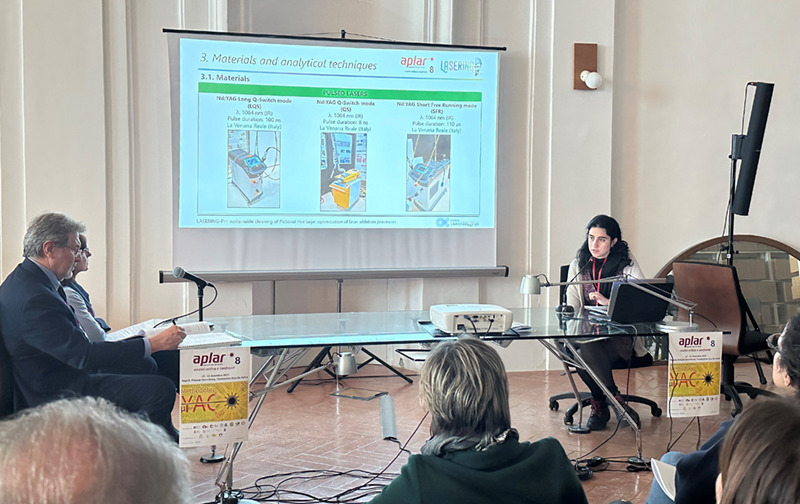In December 2023, Laura Andrés Herguedas participated in the biannual conference dedicated to laser applications in the field of conservation and restoration of Cultural Heritage APLAR 8, celebrated in Naples (Italy). She presented a conference entitled “LASERING-PH: sustainable cleaning of Pictorial Heritage: optimization of laser ablation processes”.
From 13th to 15th December 2023 there were conferences related to application of laser on easel and panel paintings, organic material, metals, stone materials, wall paintings and about diverse typology of materials, experiments and processes. Furthermore, a round table discussion was held on “what is research and industry doing in the development of new laser solution in restoration processes”.
ABSTRACT:
Wall paintings shape the appearance and symbolism of architectural and archaeological Cultural Heritage (CH). Its compositional complexity makes it susceptible to the common deterioration agents affecting CH materials. In the current context of global warming, this susceptibility has increased due to the contribution of atmospheric pollutants and greenhouse gases leading to the formation of surface deposits that not only prevent the correct reading of the artwork, but also compromise the stability of the pictorial layer. Among the current cleaning methods applied in CH, laser ablation allows the removal of surface films in a localized, gradual, and selective manner without waste generation (environmentally friendly). While its effectiveness and/or harmfulness has been extensively studied for removing surface deposits on stones, studies of its interaction on wall paintings are scarce.
In this paper, the Spanish project LASERING-PH (Reference PID2020-119838RA-I00) is presented. Focused on the investigation of the effects of different laser systems on tempera and cave paintings, the main objective is to establish safeguarding conditions to be applied on this kind of paintings. These conditions will vary depending on the composition of the painting. With this in mind, a systematic and gradual research process is being followed. The first stage is based on the behaviour of the raw materials that compose the paintings (pigments and binders separately) to the irradiation with different lasers considering wavelengths and pulse durations. The same procedure is followed on the painted mock-ups. The knowledge of the irradiation conditions that generate the least damage to the paintings will allow us a proceed onto the next stage: the cleaning of painting mock-ups artificially soiled and the cleaning of a real artwork.
This project is an international collaboration among different universities and institutions. From Spain, University of Vigo, University of Coruña, University of Granada and Escola Superior de Conservación e Restauración de Bens Culturais de Galicia (Galician School of Conservation and Restoration of Cultural Heritage). From Italy, Università di Pisa and Centro Conservazione e Restauro “La Venaria Reale”. And from Portugal, Instituto Superior Tecnico. In total 17 researchers (engineers, physicists, chemists, geologists, conservator-restorers and conservation scientists) are working on this project. Thanks to this collaboration, the lasers used are a Nd:YAG (at 1064 nm working under different modes: LQS- pulse duration: 100 ns-, QS-8 ns-, and a SFR-100 µs-), a ns Yt-doped core fiber (at 1064 nm and pulse duration of 30ns-), a ns Nd:YVO4 (at 355 nm and pulse duration of 25 ns), a fs Spectra Physics Spirit (at 1040 nm and pulse duration of 380 fs) and a µs Er:YAG (at 2940 nm and pulse duration of 350 µs). In order to know the effects of the lasers on the raw pigments, irradiations were performed in compacted pigment tablets. For the tempera paintings, a mixture of the pigment with the binder (egg yolk or rabbit glue) were applied on a lime substrate. And for the cave paintings, pigments were mixed with butter and applied onto a kaolin mixed with butter substrate or mixed with casein and applied on quartzites. First, pigment tablets were irradiated varying laser fluence to determine the effects and then, similar conditions were applied on the whole painting. These irradiated surfaces are investigated following an analytical protocol based on stereomicroscopy, colour spectrophotometry, reflectance measurement and scanning electron microscopy with energy-dispersive X-ray spectroscopy. Darkening and discolorations have been detected on the surfaces due to different levels of melting and/or cracking. Overall, the different pigment composition and painting techniques have shown different behaviours towards laser irradiation.
+info: Download the presentation


